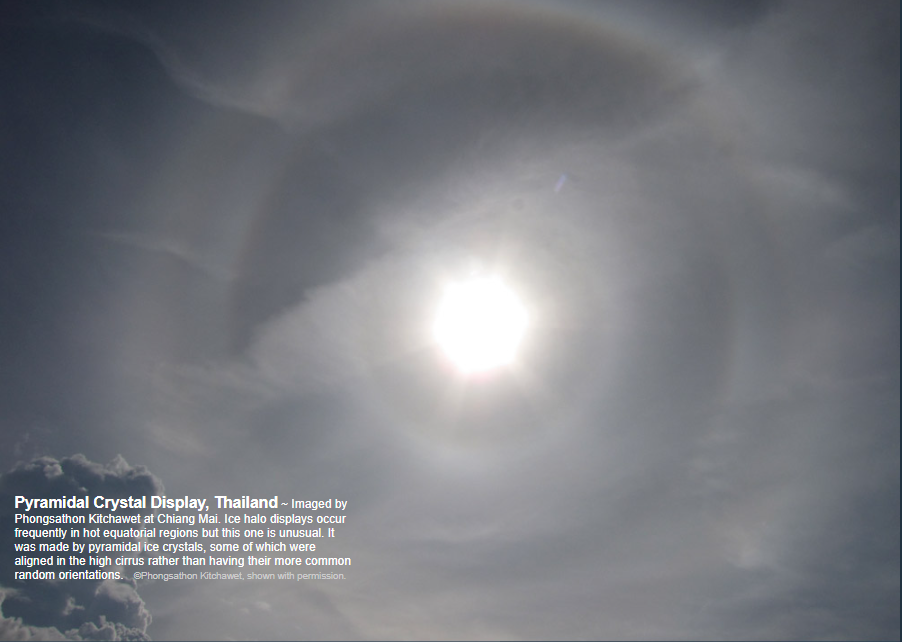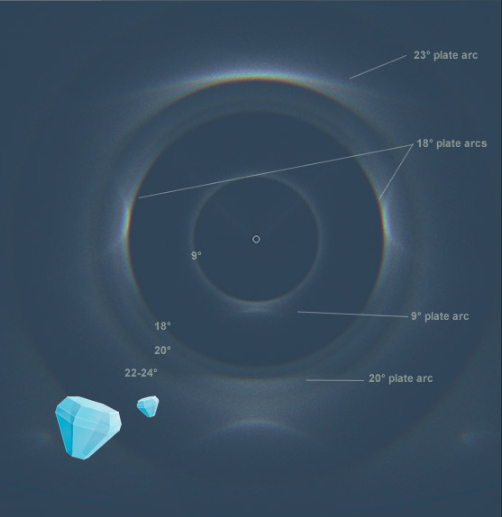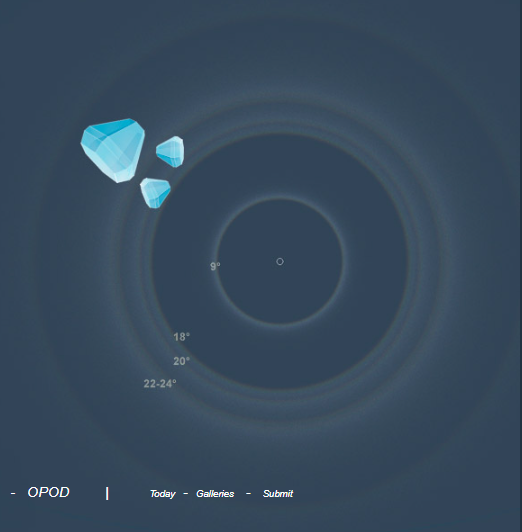OPOD Pyramidal Plate Arcs, Thailand
Pyramidal Plate Arcs: A Unique Atmospheric Optics Phenomenon in Thailand
The atmospheric optics phenomenon known as pyramidal plate arcs is a rare occurrence that has been observed in various regions around the world. One such sighting took place in Thailand, captured by the talented photographer Phongsathon Kitchawet in Chiang Mai. This particular display stands out from typical ice halo displays due to the presence of pyramidal ice crystals that were aligned in the high cirrus clouds, rather than having their more common random orientations.
When observing the image, we can identify several distinct features. Outwards from the sun, there is a clear 9° radius halo, followed by another halo at 18°. Beyond that, a broad ring can be seen, which is likely a combination of 20°, 23°, and 24° radius halos. These circular halos with different inner radii can be generated by various ray routes through randomly oriented pyramidal ice crystals.
However, what sets this display apart is the non-uniform brightness of the rings. The 9° radius halo is brightest at the bottom, indicating a slight tilt in the image. On the other hand, the 18° radius ring is brightest on each side. Additionally, a colored arc resembling an upper tangent arc can be observed at the top, approximately 23-24 degrees from the sun.
These unique characteristics suggest the presence of pyramidal "plate arcs," which are arcs created by crystals oriented similarly to ordinary plate crystals. The key difference lies in the poor alignment of pyramidal crystals due to inadequate aerodynamic drag. As a result, plate arcs made by pyramidal crystals are typically poorly defined.
To gain further insight into this phenomenon, a HaloSim computation was performed using crystals similar to those illustrated in the image. The simulation revealed that 50% of the crystals were randomly oriented, while the remaining crystals had rough plate-like orientations, with a distribution of c-axis tilts up to 12° from vertical. Interestingly, the simulation plate arcs were better defined and exhibited more features compared to those observed in the image.
Further adjustments to crystal proportions and orientations may potentially improve the accuracy of the simulation in reproducing the intricate details of the pyramidal plate arcs. However, it is important to note that even with these adjustments, there may still be additional factors at play that contribute to the unique characteristics observed in this atmospheric optics display.
In conclusion, the pyramidal plate arcs witnessed in Thailand are a captivating example of atmospheric optics. The alignment of pyramidal ice crystals in the high cirrus clouds creates distinct features such as non-uniform brightness in the halos and the presence of a colored arc resembling an upper tangent arc. While the aerodynamic drag is not conducive to proper alignment, simulations using similar crystal orientations have provided valuable insights into the nature of these plate arcs. Nonetheless, further research is required to fully understand the intricacies of this remarkable atmospheric phenomenon.

Pyramidal Crystal Display, Thailand ~ Imaged by Phongsathon Kitchawet at Chiang Mai. Ice halo displays occur frequently in hot equatorial regions but this one is unusual. It was made by pyramidal ice crystals, some of which were aligned in the high cirrus rather than having their more common random orientations. ©Phongsathon Kitchawet, shown with permission.
Outwards from the sun there is a clear 9� radius halo then another at 18�. Beyond that we see a broad ring that could be a combination of 20, 23 and 24� radius halos. Circular halos with all these inner radii can be generated by various ray routes through randomly oriented pyramidal ice crystals.
But the rings of the image are not uniformly bright. The 9� is brightest at the bottom (the image is tilted slightly).
The 18� radius ring is brightest on each side.
There is a coloured arc rather like an upper tangent arc at top some 23-24 degrees from the sun.
These are hints of pyramidal �plate arcs� � arcs made by crystals oriented like ordinary plate crystals. The difference is that aerodynamic drag is not good at orienting pyramidal crystals. Their alignment is poor and the plate arcs are usually poorly defined.
At right is a HaloSim computation for the display using crystals like those illustrated. 50% were randomly oriented and the remainder had rough plate type orientations (distribution of c axis tilts up to �12� from vertical). At lower right is a simulation with all the crystals randomly aligned.
The simulation plate arcs are better defined and show more features than those of the image. The bright upper arc is a 23� plate arc. Further adjustment of crystal proportions and orientations might better reproduce the details but often it does not. There could be more going on.


Note: this article has been automatically converted from the old site and may not appear as intended. You can find the original article here.
Reference Atmospheric Optics
If you use any of the definitions, information, or data presented on Atmospheric Optics, please copy the link or reference below to properly credit us as the reference source. Thank you!
-
<a href="https://atoptics.co.uk/blog/opod-pyramidal-plate-arcs-thailand/">OPOD Pyramidal Plate Arcs, Thailand</a>
-
"OPOD Pyramidal Plate Arcs, Thailand". Atmospheric Optics. Accessed on November 26, 2024. https://atoptics.co.uk/blog/opod-pyramidal-plate-arcs-thailand/.
-
"OPOD Pyramidal Plate Arcs, Thailand". Atmospheric Optics, https://atoptics.co.uk/blog/opod-pyramidal-plate-arcs-thailand/. Accessed 26 November, 2024
-
OPOD Pyramidal Plate Arcs, Thailand. Atmospheric Optics. Retrieved from https://atoptics.co.uk/blog/opod-pyramidal-plate-arcs-thailand/.